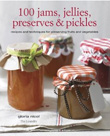PLUMS EVERY WAY YOU TURN
Thursday September 16th 2010, 10:52 pm

Month nine Tigress’s can jam canning challenge and for September the ingredient chosen by Kate at the Hip Girl’s Guide to Homemaking is stone fruits. It couldn’t have been a better choice for me than this, as where I live is plum country. We even have our own local variety, the Blaisdon plum, that grows just about everywhere and apart from the occasional year when a late frost might have nipped an abundant harvest in the bud, we are usually all drowning in plums by the end of August. As well as Blaisdon trees growing in peoples gardens they grow along hedgerows and overhang onto public footpaths. In the lane that leads up to my house I can count at least 10 trees. The big problem is that not all the fruit will be within arms reach and most will be impossible to harvest no matter how resourceful and well equipped you might be.
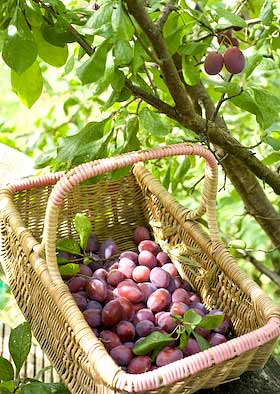
Blaisdons were once a popular variety grown for the jam making trade but became less useful once freezing fruit opened up the market, enabling manufacturers to go further afield and shop around on price. I read somewhere of someone locally with a small orchard of Blaisdons where a railway line once ran along the bottom of the garden, so the freshly picked fruit was loaded straight onto the train that then chugged its way directly to the factory, collecting fruit from others along the way.
Stephen, who lives next door but one from me, has a Blaisdon tree that very conveniently overhangs a raised decking platform in his garden. He said I could help myself to his crop, and so of course I did. This meant my September ingredient has not only been plentiful but also absolutely free. As well as these purple plums I picked some lovely acid yellow ones that grow in the field behind the house. I haven’t a clue what kind they are. And then there are the damsons… I’m not even going to include them here, suffice to say I’ve picked basket loads.

As is always the way when dealing with a glut, you have to act fast and be ready for processing. It is a mad dash to get everything tucked in and put away before the fruit flies decide to set up camp in your kitchen. I wanted to save as many plums as possible to use as ingredients later, so some have been cooked and stoned then packed into containers in the freezer. The freezer has its uses but it fills up fast and I suspect costs an outlandish amount to run. Frozen ingredients can rack up considerable additional hidden costs making my free plums not quite such a great deal. I now prefer to can as much produce as possible. Once in the jar and processed, the fruit is ready-to-go whenever required with no thawing time, you simply pop the seal and run with it.
One of my favourite discoveries since my canning journey began is bottling fruit compotes. These ready-made desserts are then instantly available and the processing means you can use less sugar. This month, as well as plums done and dusted every conceivable way, whole, squashed and pureed, specially for the Can Jam I’ve made a plum compote and filled my favourite vintage 70’s Kilner jars. I love the look of them and think it’s about time Ravenhead Kilner had the imagination to reissue them. Don’t they know bottling is back!

PLUM & BLUEBERRY COMPOTE IN CALVADOS SYRUP
Adapted from a recipe in my favourite book Fancy Pantry (1986) by Helen Witty
For each 1litre (1 quart) jar you will need:
850g (1 3/4lbs) whole plums
125g (1 cup) blueberries, rinsed and drained
3 Tbsp calvados or other good brandy
For the syrup:
275g (1 1/2 cups) sugar
0.5ltr (2 cups) water
Prepare the water bath, jars and seals ready for canning. For more info about how to hot water process, refer to the guide here.
Make the syrup by combining the sugar and water in a pan and stir to dissolve the sugar over a medium heat. Once dissolved turn up the heat and bring to the boil, then simmer uncovered for 5 minutes. Pierce each plum 2 or 3 times with a skewer or tooth pick then gently poach half of the plums for a jar at a time in the simmering syrup for about 3 minutes.
Gently lift the plums out of the syrup and pack them into a hot jar so it is filled to just below half way. Place the blueberries on top, allowing them to fall down into the gaps between the plums and the inside of the jar in a decorative way. Poach the other half of the plums in the same way then fill the jar with them, packing them to leave the appropriate amount of headroom for your type of jar. Pour 3 Tbsp calvados over the plums then top up with syrup.
De-bubble the sides using a small spatula or chopstick, wipe jar rims clean, before sealing and placing in the hot water bath. Process for 25 minutes, remove from the bath, then leave till cold before testing the seals. Label and store.
Scale down for 500ml (1/2pt) jars and process for 20 minutes.

THE BIG AUTUMN BLANKET WASHATHON
Wednesday September 01st 2010, 5:46 pm

Today is a gloriously sunny day but it doesn’t fool me. We’ve already had a few nippy evenings, sent to prepare us for autumn ahead. Hopefully, we’re due a good September weatherwise but Autumn’s coming whether we like it or not. So as well as lots of canning projects over the next 2 months to stock up the store cupboard (more plums, damsons, apples as well as pears, quinces and all the hedgerow berries to look forward too), I’m also trying to get a few other jobs done to make life warm and cosy. I really must replace the fire bricks in the Rayburn soon, it’s no good leaving it till the weather has already taken a turn for the worse. There is a box of them beside the Rayburn, been there since last year. And I need to get the chimneys swept.

I intended laundering all my blankets in the spring, but didn’t get around to it, so today resolved to make a start. I love blankets and as you can see, once they are collected together, I have quite a few. Vintage Welsh blankets are my favourites, the weaves and colours are just wonderful. So first I piled all the blankets up so I can work my way through them, washing them one by one, restoring them, to their pristine glory ready for colder months ahead. I have 5 cats so my house consists of lots of cat beds, in fact it is lots of cat beds all joined together. The blankets collect fur as well as dirty wet paw marks.

I have on occasions washed blankets in the washing machine with sometimes good, sometimes disastrous results. I’m not prepared to chance it with any of my precious blankets. They are all pure wool and some feel more robust than others. If your blankets say on the label to wash in the machine, then you’ll be fine. Don’t think any of mine have labels so common sense is the best approach. Once wet, they become big heavy unwieldy things to handle so you do need a bit of muscle and a cup of tea and a biscuit (or a prize winning scone perhaps!) every now and again.

HOW TO WASH A BLANKET
Give your blanket a good shake out doors. If like mine, they have animal hairs on them, it is a good idea to run the hoover over the hairy bits, holding it taught as the suction of the nozzle removes the excess. If your blanket has any stains, these will need to be dealt with as appropriate for its type. A good old fashioned bar of soap rubbed into the stained area will sort out most stains, but dried blood or grease marks may require a product designed specifically for that job. Don’t rub the area with too much gusto otherwise it could felt the surface of the wool.
If your blanket is too large to fit in the sink use the bath. Fill the sink or bath with plenty of lukewarm water, so the blanket can move about in it, and add some soap flakes, Woolite or Stergene to give a good lather. Lower the blanket into the water and agitate it gently, working around the blanket but not rubbing it excessively. Remove the plug and allow the water to drain away and try and gently squeeze out as much excess water from the blanket as you can. This is where you need muscles. A washing up bowl or bucket is also useful here, as you can lift the blanket into it while you rinse out the sink or bath and refill with clean warm water for the first rinse. It is really important that wool blankets are not subjected to sharp changes in temperature to prevent felting, so try to keep the water at a similar lukewarm temperature throughout.
Rinse the blanket a couple of times in clean water until the water stays clean and shows no sign of suds. You can add fabric conditioner to the final rinse if you wish. Lift the blanket and squeeze as much water as you can from it. If you have a washing machine robust enough to take the wet blanket you can then spin it in the machine. If the blanket is too heavy for your machine you will need to fold the blanket, place it flat on a large towel and then roll the towel up so it soaks up the excess liquid from the blanket.
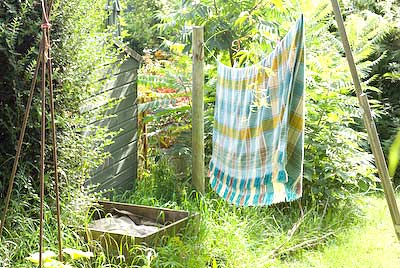
Hang the damp blanket on a washing line out in the fresh air and use plenty of clothes pegs to hold it straight and taut. Pull the blanket into shape so warp and weft threads run straight, giving any tight edges a gentle tug and stroke out any creases. A gentle breeze on a warm day is the ideal scenario so your blanket will dry quickly and be in great shape. If you have the time, move the blanket part way through its drying time and re-peg, that way you wont end up with a crease where it is folded over the line and it will prevent the pegs from making indented marks on the fabric. Your blanket should now be clean and soft as well as smelling as fresh as a daisy.
So that’s one blanket sorted. Only another 15 to go!

SCONES AT THE VILLAGE SHOW
Tuesday August 31st 2010, 11:50 am
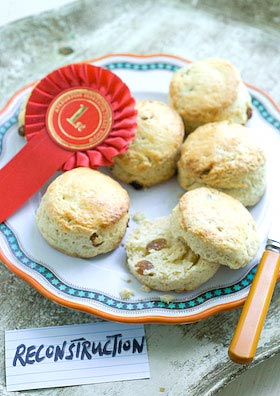
I want to share my joy with you, the moment my scones, entered into the produce show at our village hall at the weekend, won first prize. I certainly never expected this triumph so when I went into the hall to find out the results and spotted I’d been awarded the first prize, OK I can see now, it was a bit over the top, running round the hall punching the air with my jumper pulled up over my head!
I’d been in a right quandary in the lead up to the event. Last weeks British Bake Off programme on TV had featured scones and it was only then I thought I’d enter some in the Aylburton show. The scone class has always seemed too highly contested for me to have winning ambitions. After the British Bake Off programme I pressed the red button to watch expert baker and programme judge Paul Hollywood show how to make his ‘failsafe’ scones. With classic baking like this it is always extraordinary how the same ingredients can be mixed to give totally different results. I was appalled that he used 2 eggs and when out of the oven I thought his scones too high baked. Straight to Twitter someone described his scones as ‘pants’ so I wasn’t alone. How we all have an opinion; to add fruit or leave plain, use self raising flour or plain, adding the traditional cream of tartar and baking soda yourself, using sour milk, buttermilk etc etc. See this excellent and comprehensive roundup about scone making.
Even though I’ve made scones loads of times this all sent me a bit wobbly and over the following few days I made several batches trying different recipes, other than my own, thinking they would be appreciably better than mine, but none worked out how I wanted. On the morning of the show facing the decision whether to enter fruit scones or not I fell back on my own tried and tested recipe that you can find here. The first batch I made I forgot to put the sugar in. There was just enough time to make another lot and get it right, though the look of the second batch wasn’t so good. Suffice to say, got down to the village hall, added my entry to the baking table and as they say… the rest is history.
Couldn’t find my favourite cutter so had to use a slightly larger 6.5cm (2 1/2in) diameter cutter instead. This made 7 scones and the last 2 had to be cut from reformed dough, which isn’t ideal if you are aspiring for 6 perfect matching specimens. Also as the category was for fruit scones I added 50g sultanas to my plain scone recipe as well. Paul Hollywood gave a good tip in his red button masterclass. He said when brushing the tops of the scones with milk/egg wash watch none drips down the sides as this can set and prevent the scones from rising evenly. Mind you, a wonky scone looks quite good, don’t you think?
Our village show is really great. Very charming and relaxed. So relaxed in fact that you can never guauge what the criteria is for success. You can spend time faffing about with your presentation only to be beaten by a bottle of ketchup in a plastic bottle, but it is all good fun and everyone pretends they are taking it in good heart and that’s the main thing. Will be posting more pictures later but this is my highlight of the show this year – Banana Dog.
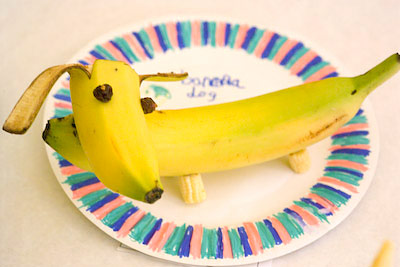
BOTTLING TOMATOES & THE ACIDITY CUSP
Monday August 16th 2010, 1:05 pm
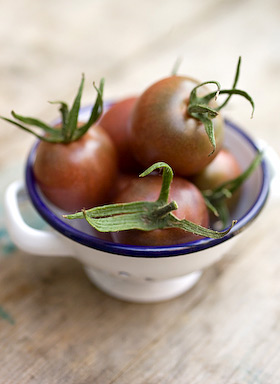
Month eight Tigress’s can jam canning challenge and for August the ingredient chosen by the inspired and inspiring Julia is tomatoes. My relationship with this ubiquitous fruit has been a checkered one. I hated tomatoes as a kid but learnt to tolerate them later on. I do like them as a sauce for pizza, applied with a lightness of touch though. I can now eat cherry tomatoes raw and, like biting into any fruit, appreciate their sweetness so I suppose you could say I’ve made progress.
But it is as objects of beauty that tomatoes especially come into their own. The resurgence of interest in growing heritage varieties has brought all these wonderfully coloured tomatoes to the fore; striped, heart and pear shaped, shaded like a shop display of lipsticks, from gold to chocolate. They are all so fantastically photogenic and worth growing for looks alone.
As an ingredient for canning, they are on the acidity cusp. Tomatoes require special attention for bottling safely using the water processing method or else should be pressure canned. They are only just on the acid side of neutral and acidity can vary for different varieties, so it is necessary to add a little more acidity in the form of lemon juice or citric acid to make sure they stay safely putt. It is important that time spent preserving has a very definite pay off later so it makes sense for me to bottle really useful tomato passata-type sauces for cooking up further down the line into pizza toppings, pasta sauces or as additions to winter casseroles.
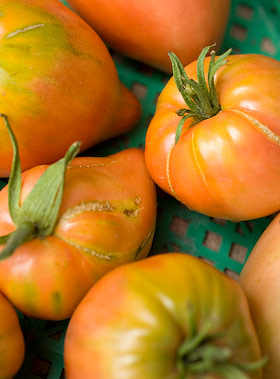
Each year I begin the growing season with high hopes for an extensive range of weird and wonderful tomato varieties. I don’t have a greenhouse so can only grow toms out in the open. We’ve had two consecutive years of blight bringing these plans to a soggy and disappointingly diseased halt, but this year the weather has been kinder. Tinned tomatoes are as cheap as chips, so I don’t think it is really cost effective to bottle tomatoes unless you have your own homegrown supply or you are able to mop up someone elses glut. The plants I have growing in the garden are still some way from the ‘glut’ stage. Thankfully my neighbour Jane has a greenhouse as well as green fingers. She sells her excess garden produce from her garden wall. Last week I picked up four generous punnets of yellow and red tomatoes from the wall and dropped my payment into the honesty box provided.
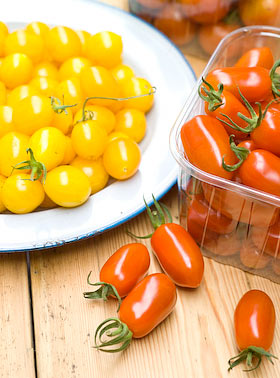
So first a basic tomato sauce. These cherry tomato varieties are as sweet as anything though perhaps not the most ideal kinds for bottling. For sauces, larger fleshy varieties like Roma and San Marzano are good. Skinning so many tiny fruits was definitely out of the question for starters. Tomatoes can be very watery, which means that they will require considerable cooking to reduce, thicken and intensify the flavour, unless some of the liquid is removed first.
In order to give a fresher flavoured result with less cooking time I began by slitting each fruit and removing the seeds by running my thumb quickly through their middles, collecting the seeds in a sieve placed over a bowl. Any collected juice would come in handy later. After a brief cooking time of 10 minutes the de-seeded tomatoes were then processed using a passata mill, running it through several times to separate the skins from the pulp. The passata mill is a bit of kit I acquired some years ago when dreaming of a bounteous tomato crop that never materialised. The mill has sat unused in its box ever since so this was its first opportunity to prove its worth. I must say that I wasn’t too impressed. Passata-ing the tomatoes was a messy and annoying business (compounded by trying to take photographs at the same time). Tomato juice splattered all over the place and possibly it was my fault, but juice was squirting out the handle side as well! Next time I will most likely use my regular food mill over a bowl, which though still requiring patience would be less messy and more controllable. Depending on the scale of the project, to remove skins and any stray seeds you could simply push the tomatoes through a sieve if you prefer. Still too watery for my liking, I strained the flesh again briefly in a sieve collecting more juice to add to what had been collected earlier. 2.5Kg (5 1/2lbs) of tomatoes resulted in 775g (1 3/4lbs) puree and 750ml (1.3 pts) of juice.
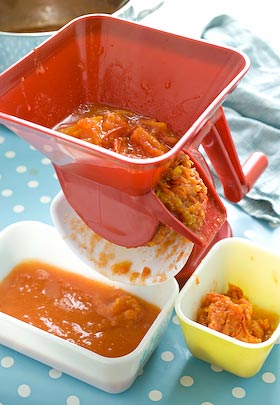
HOW TO BOTTLE TOMATO PUREE
Prepare the water bath, jars and seals ready for bottling (canning). For more info about how to hot water process, refer to the guide here.
Put the pureed tomatoes in a pan and simmer for a short time to reach a consistency that suits you so excess juice has evaporated. If the puree is already thick enough simply bring to boiling point. I added 1 tsp sea salt (a non essential, so add salt to own taste or leave out all together) plus an aditional acidic booster. As a general guide you need to add one of the following to every 500ml (1 pt) tomato puree: 1Tbsp lemon juice or 1/4 tsp citric acid. I used balsamic vinegar instead, adding 2 Tbsp balsamic vinegar per 500ml (1pt) puree.
Place a basil leaf inside each jar against the glass and fill jars with tomato, leaving headspace required for your type of jar. Remove bubbles from sides of jars using a small spatula, wipe rims clean and seal. Process 500ml (1 pt) jars for 35 mins and 1ltr (quart) jars for 45 mins. Remove jars from water bath and leave till cold before testing the seals. Any jars with loose seals will require reprocessing or you can keep them in the fridge for using up within a few days. Remember to label all your jars before storing them.
My tomatoes made 2 x 350g (12oz) jars of sauce plus a bit more that I had with pasta for my dinner that evening.
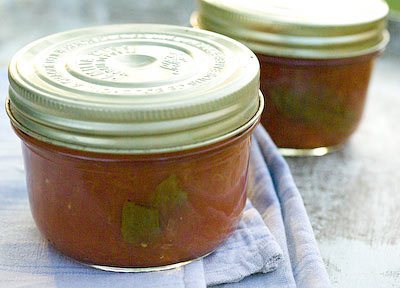
WHAT TO DO WITH THE JUICE
It seemed a shame to waste the lovely sweet juice collected whilst extracting the tomato puree, so I decided to turn it into tomato jelly. You could flavour tomato jelly with fresh ginger and ground coriander or finely chopped chilli. After much deliberation I eventually chose vanilla and white pepper for a jelly with a sweet / savoury crossover. This jelly is delicious on sourdough toast with cream cheese and I used it to fill tiny savoury pastry cases, topped with sour cream or crumbled goats cheese for a really exquisite little mouthful.
As tomato juice is lacking in pectin, a boost in the form of the addition of lemon or apple juice is helpful. Having bottled some whitecurrant juice several weeks earlier to use at times like this, I added some of that for its setting quality. Preserving sugar containing added pectin could also be employed here. Adjust proportions to suit what you have available.
TOMATO, VANILLA AND WHITE PEPPER JELLY
750ml (1.3 pts) tomato juice (a byproduct of making the puree above)
550g (1 1/4lb) sugar
Juice of 1 lemon or 150ml (2/3 cup) whitecurrant juice
1 vanilla pod, split and seeds scraped from inside
1/2 tsp ground white pepper
Prepare the water bath, jars and seals ready for canning. For more info about how to hot water process, refer to the guide here.
Pour the juice through a jelly bag, collecting the juice in a measuring jug. To every 600ml (1 pt) juice add 450g (1 lb sugar). Place all the ingredients in a preserving pan. Stir constantly over low heat until the sugar has dissolved then turn the heat up to bring to a rolling boil. Boil to setting point, (it took me about 10 minutes) when a blob of syrup on a cold plate will formed a skin when you push your finger over the top of it. If using a jam thermometer it will register 220F 105C. Remove the vanilla pod and fill hot jars, leaving the required headroom for their type. De-bubble the sides using a small spatula or chopstick, wipe jar rims clean, before sealing and placing in the hot water bath. Process for 10 minutes, remove from the bath, then leave till cold before testing the seals. Label and store.
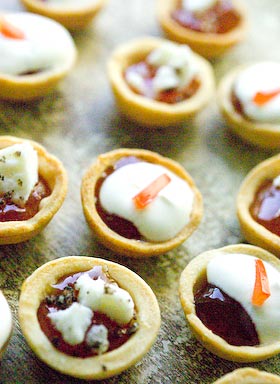
The ratio of sugar to juice is the classic one used when making jellies. This jelly is very nice indeed but I will be tempted to cut down on the amount of sugar when I make this next. It is often safe to keep jams and jellies without hot water processing (canning) them. If you do can them you are making doubly certain that they will be preserved safely for a year or even longer.
SUMMER PICKLED
Tuesday July 20th 2010, 9:56 am
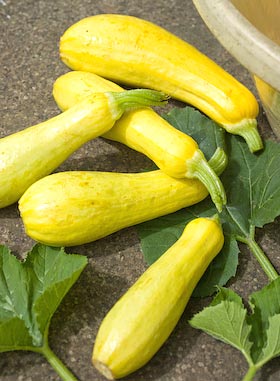
Month seven Tigress’s can jam canning challenge and for July the choice of ingredients was mine, and I choose cucurbits. I began by making a jam to use up some Galia melons I’d bought to photograph, along with some frozen plums that needed using from the freezer before this years harvest requires the space. Anyhow, that’s another story, jam wasn’t what I wanted from the July canjam. The best thing about taking part in this global canning event is the stretch, the discovering anew. I was wanting to do some pickling.

I am a pickle novice, having never been drawn to them, through lack of positive experiences. Pickles for me have been onions served with cheese, English ploughmans-lunch style, Branston pickle, a manufactured brown sweet gloopy relish that has its moments in a cheese butty (sandwich), and pickled beetroot, that was once the only way you ever found this root veg and that comes with a powerful acetic hit. I do have one recollection of my friend Mary eating pickled umeboshi plums to ward off sea sickness when island hopping in Greece, they seemed pretty disgusting but did work. Later in life the pickled ginger with sushi element crept into my middle class lifestyle. That’s it, the full extent of my pickling life …. so far.
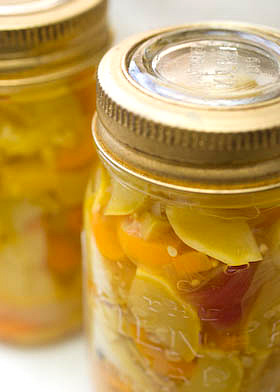
I’ve read loads of recipes and am intrigued by what is called in the US ‘Bread and Butter’ pickle. It obviously doesn’t mean these are included as ingredients but does it mean that it is meant to be eaten on bread and butter? I assumed this to be so until a google search ‘what does bread and butter pickle mean?’ pointed out another alternative. Something that is your ‘bread and butter’ is your main form of income, so bread and butter pickle could be the breadwinner of the pantry, your stalwart pickle, a good all rounder that you can’t do without. Anymore ideas, please let me know. I ended up making up a recipe based on the many I’d read. I think my summer squash pickle is more or less a bread and butter pickle, made with summer squash instead of cucumbers.
Luckily, this week in the Taurus market garden, the first summer squashes are ready to harvest. Some Early Prolific straightneck squashes provided the perfect starting point for my foray into pickling. This yellow squash is lovely eaten raw and has an excellent flavour. I decided to go for colour, adding plump purple scallions and orange sweet peppers into the mix. As often happens, the colours change during preparation, in particular the purple onions lost their hue, but I still ended up with a beautifully coloured pickle with a summery vibe.
If you, like me, have never really tried pickles, MAKE THIS ONE!!!! It is just fantastic. I only made it 2 days ago and even without the usual month mellowing off period, it tastes amazing. I haven’t a clue what you serve it with, but straight from the jar with a fork is working for me. This was just what I needed to turn me into a pickle fiend.

SUMMER SQUASH PICKLE
Makes 6 x 500ml (1pint) jars
1.5Kg ( 3 1/4lbs) summer squash courgettes or small zucchini
400g (14 oz) onions
300g (11oz) sweet peppers, 2-3 peppers
200g (7 oz) salt
1 ltr (1 3/4 pint) white wine vinegar
250ml (1/2 pt) water
450g (1lb) sugar
1 1/2 tsp celery seed
2 Tbsp mustard seed
1 tsp ground cinnamon
1 tsp turmeric
6 small dried red chillies
1 tsp black peppercorns
Top and tail the squash and cut into uniform sized slices, so they are about .5cm (1/4 in) thick. Slice the onions and deseed and slice the peppers. Place all the vegetables in a glass bowl and sprinkle with the salt, turning them all over so the salt is evenly distributed. Cover the bowl and leave for 12-24 hours. Drain off the liquid that is drawn from the veg, rinsing and draining thoroughly several times to remove as much salt as possible, finally leaving to drain.
Prepare the water bath, jars and seals ready for canning. For more info about how to hot water process, refer to the guide here. Place the vinegar, water, sugar and spices in a pan and bring to a simmer, stirring to dissolve the sugar. Simmer for 5 minutes then add the vegetables. Bring back to the boil and simmer for 5 minutes. Pack the vegetables into hot sterilised jars, filling them to leave required headroom, then top up with the vinegar, distributing the seeds evenly amongst the jars. Seal and process the jars for 10 minutes. Pickles always improve on keeping for at least a month before opening, if you can wait that long.
Pickles have a high acid content so can often be made without hot water processing (canning) them. If you can them you are making doubly certain that they will be preserved safely for a year or more.

GOT MY HEAD STUCK IN A RUMTOPF
Tuesday July 13th 2010, 9:57 pm
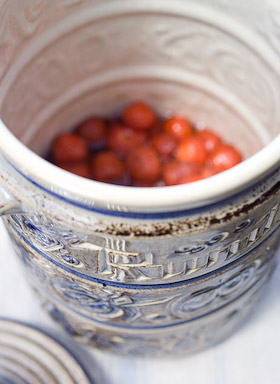
Tigress got the ball rolling back in June when she wrote about her plans to start a rumtopf using her new-fandagly fermenting crock. I don’t think I’m the only one she inspired to rumtopf-along with her, but first I needed a suitable jar. The only pots I’ve seen for making rumtopf have always struck me as hideous; big bulbous lumpy jars illustrated with fruits and the word ‘rumtopf’ etched on the front, the recipe is right there on the jar. A fermenting crock would be a very cool to use, but as they are hard to find and when found cost in the region of £80, one of them was way out of my league. I kept my eye on Ebay and eventually found a jar that I could live with. You can make do with a tall clip-top preserving jar instead if you like but I’m enjoying making my rumtopf in its own purpose designed container.
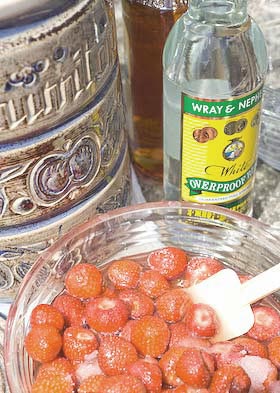
So the jar eventually arrived and it is definitely vintage 70’s. I peered inside and caught a glorious wiff. The jar was not only vintage but had been used before. I knew this as the lightly crazed inside had soaked up previous alcohol and fruit flavours. It smelt fabulous, fruity spirit with a hint of lovage! I couldn’t stop sniffing and shoving my head further inside to soak up the aroma. The jar is about head size, you could effortlessly slip your head inside whilst becoming mesmerised by this magical scent and the desire for more, but slipping it out again may not have been quite so easy. I stopped short of ending up in casualty with a rumtopf on my head. That would have been ridiculous but, come to think of it, would have ensured a mention in the Forest Review.
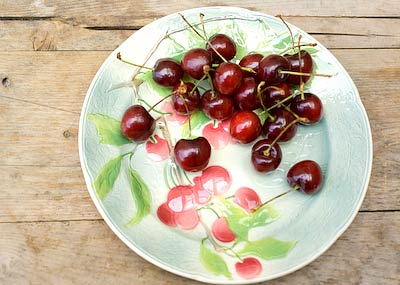
So what is a rumtopf? It is a way of preserving fruit in alcohol. You start it June – July time, add different fruits in layers as they come into season, throughout the summer and autumn, along with some sugar and enough rum or brandy to keep it submerged, and when it is full, about 6 – 8 weeks before Christmas, you then leave it till ready to devour at Christmas time. The contents can be decanted into kilner jars to give as gifts, the fruit can be eaten with cream or ice cream and the alcohol, which I understand is deceivingly dangerous, can be drunk as a liqueur or added to sparkling wine.
Most fruits are suitable with just a few exceptions; melon is too watery, the skins of blueberries and gooseberries go hard, bananas turn to mush, citrus fruits and rhubarb are a no-no. Traditionally you start with the first strawberries of the year, any amount between 250g – 750g plus half its weight in sugar. Remove the stalks and leave the fruit and sugar in a glass dish to marinate overnight and help release the juices before decanting it into the rumtopf jar. Pour rum or brandy over it until it is completely submerged, then find a plate or saucer that will fit inside the jar and push it under the alcohol so that the fruit can’t bob up to the top. I have read that the alcohol should be at least 54% proof and as spirits on general sale are usually around the 40% mark I had to seek out some overproof stuff. Asda sells an overproof white rum at 63%, so I mixed it, two thirds overproof to one third normal dark rum to get somewhere near the 54%, make the rum go further and give it a darker colour. I think this may be a mere detail and am sure that most people don’t go to so much trouble.
You continue to add more fruity layers as they appear; raspberries, cherries, nectarines, peaches, pears, plums, apricots and blackberries. Use any amount of fruit you have, adding half its weight in sugar each time and making sure to add more alcohol when needed to keep it covered. Cover the top of the jar with clingfilm and put the lid on top of that then leave it in a cool place out of the way to do its thing. If using a clear glass preserving jar, keep in a dark place as well. I’m up to my third layer of fruit so far but just can’t stop myself having a sniff everytime I walk by the jar.
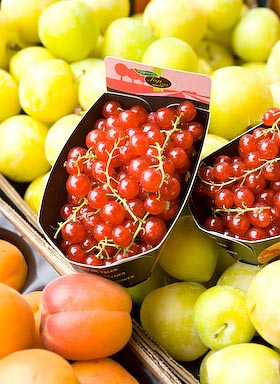
FIRST HOMEGROWN RASPBERRIES
Saturday July 10th 2010, 2:05 pm
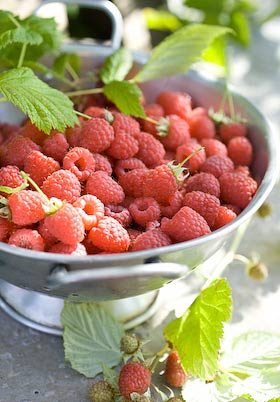
The raspberries I planted last year are suddenly heavy with fruit. I picked almost a kilo the other day and I’m feeling really pleased. Not that I can take much credit for this, raspberries are such an easy fruit to grow. Apart from planting them in the first place, banging a few poles along the row and stretching wires across them to provide some support to tie the canes too, this fruit hasn’t called out for much attention. Raspberries are really a weed as they send out their runners all over the place. I’ve allowed wild strawberries to make ground cover underneath the raspberries and the runners just grow up through this dense strawberry leaf carpet. Both seemingly grow effortlessly so I feel no compunction as regards thinning it all out now and again, it will grow back before you know it. In the autumn some of these runners are destined for the allotment, so I’ll have even more fruit in the years to come. This is all part of the bigger picture, to create the jammin equivalent of Willy Wonka’s Chocolate Factory, aka Gloria’s Glorious Jam Emporium.
Raspberries smell amazing as they cook and fill the whole house with a wonderful fragrance. I decided to use them to make the raspberry and peach jam from my book, Fruits of the Earth as it is one of my favourites. The jams I prefer usually fit into the tart, robust flavours category, but this jam isn’t quite like that, but gentler and especially fragrant and summery. This is also one of the rare exceptions when I have to buy in an ingredient that hasn’t been grown nearby. I don’t yet have access to any local peaches or nectarines so must, for the time being, content myself with sourcing the best ones I can find anywhere I can find them. At least by making a special visit to Adam Scotts in Coleford, the only independent fruit and veg shop in the forest, I shouldn’t feel bad about buying fruit from further afield. It is such a great shop and I often go there to photograph the display out front. They do sell locally sourced produce when they can.
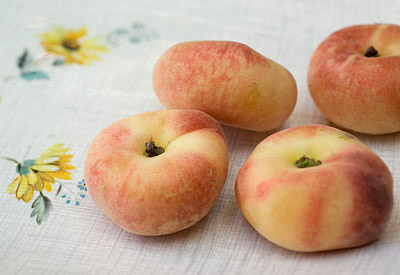
Recently they have been selling flat peaches, which seem to have become all the rage; they must be if they’ve reached Coleford already. Apart from these peaches looking fabulous, they taste great and seem to be RIPE when you buy them, ripe but still firm, amazing! A far cry from those rock hard supermarket peaches. When you bite into a flat peach, their flesh is white and it is almost enough of a treat to just stick your head in the bag when you get home and draw in their high peachy scent. These were the best peaches at their peak on the day, so I chose them. The best thing about harvesting your own fruit is getting it straight into the jam kettle, without a moment to lose, so none of the freshness is lost.
The recipe starts by heating the raspberries to release the juice, then you push it through a sieve or food mill to collect the puree. The raspberry pulp and seeds I collected is now macerating in a Kilner jar of white wine vinegar, where it will stay for the next month or so. The resulting raspberry vinegar will be delicious for summer salad dressings, so nothing wasted. In the few days since I picked the last raspberries, another batch have ripened. I haven’t netted any of my fruit bushes. Luckily, with so much fruit around, the birds are being kind for once.
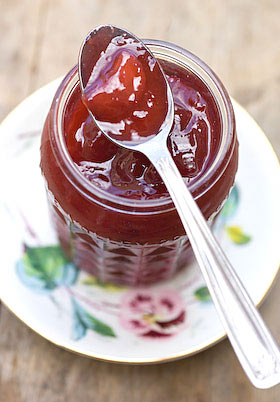
RASPBERRY & PEACH JAM
Makes 1.6Kg (3lb 8oz)
700g (1lb 9oz) raspberries
700g (1lb 9oz) ripe peaches
1Kg (2lb 4oz) sugar
juice of 2 large lemons
Place the raspberries in a pan over gentle heat to release their juice and mash with the back of a spoon. Once they are soft and juicy, push through a sieve or process with a food mill using a fine mesh, collecting the puree. (As mentioned above, you can use the seeds and pulp that remain in the sieve to make raspberry vinegar.) Place the puree and 500g (1lb 2 oz) sugar and the juice of 1 lemon in a pan, bring to a simmer, stirring all the while until the sugar has dissolved, then pour into a glass bowl, cover and leave overnight in the fridge.
Skin the peaches by placing them one by one in boiling water for a minute or 2, then into cold water. The skins should slip off the fruit easily with the help of a sharp knife. Halve and remove the stones then chop the peaches into pieces, keeping them quite chunky. Place peaches with remaining sugar and lemon juice in a pan and heat gently to a simmer, stirring to dissolve the sugar. Pour into a glass bowl, cover and leave over night.
The next day, simply combine the raspberries and peaches in a preserving pan, heat and boil rapidly until setting point is reached. (This should only take 10-15 minutes.) Leave to cool for 5 minutes then stir to distribute the peach pieces, before pouring into hot sterilised jars and seal.
By all means miss out the ‘leaving fruits, sugar and lemon in glass bowls overnight’ part if you wish to speed up the process. This method of preparing jams in stages sometimes improves flavours. Also, though this recipe will make a jam that keeps well, to be especially careful and improve keeping time, by all means follow the usual canning procedures by using suitable preserving jars and hot water processing for 10 minutes if you are into canning.
CHERRY PICKING IN JULY
Saturday July 03rd 2010, 4:44 pm
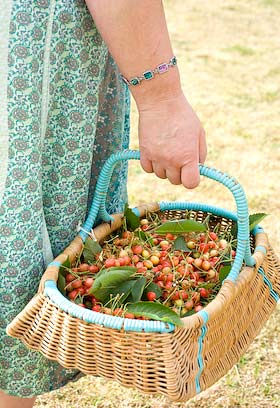
I grew up in a Lancashire mill town, in a brick built terraced house with a flag-stoned back yard. Apart from a short period when Uncle Tom and Aunty Nora owned a market garden, when I was about seven years old, I never saw first hand how fruit and vegetables grew. I can recollect a few occasions when cherries were in season and my Dad would buy a brown paper bagful from the greengrocer. Dad liked cherries. These bright polished berries were a thing of beauty. An essential part of this rarely played out ritual was to sort them into singles, joined pairs to hang over your ears like pretend fruity earings, and bunches of three or even four to balance on your head, Carmen Miranda Style. Then they were wolfed down with great delight and the stones and stalks discarded. As I’d never seen them growing on the tree I hadn’t the slightest inkling that this fruit could be British.
As I grew older I thought that France was the big cherry capital of the world as there was something about French style; cherry motifs stencilled on crockery and embroidered on cute shelf edgings that gave them assumed ownership. I’ve got an old Habitat catalogue from the 70’s which includes a feature on making cherry jam, tapping into that Elizabeth David influenced generation, when discovering all things French was the thing. It has only been relatively recently that I’ve realised we have a rich tradition of cherry growing here in the UK, albeit a dwindling one.
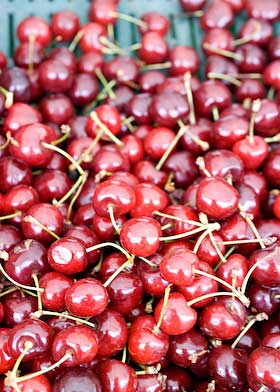
According to Food Lovers Britain, who are behind CherryAid, a campaign to save the British Cherry, in the last 50 years Britain has lost 90% of its cherry orchards. Most of the cherries available to us are now imported. The campaign aims to encourage us to celebrate the British cherry, ask for British grown fruit where we can and plant a cherry tree, hopefully choosing an old-English variety.
A week or two ago, my rhubarb man (see my last but one blog post) gave me a big colanderful of sweet cherries from his tree. It had been a race to harvest them before the birds nabbed them all. An abundant crop is necessary to guarantee that after the birds get their fill there’s still some left for us humans. My haul meant there were handfuls to eat fresh but I wanted to preserve some as well so decided to pickle them.
I looked up ‘Cerises Au Vinaigre’ in Jane Grigsons Fruit Book, always a reliable reference book for these things, and also found ‘Spiced Cherries’ in The Perfect Pickle Book by David Mabey and David Collison. Pickling cherries is simplicity itself, you just make a sweetish, spicy vinegary syrup, pour it over the prepared fruit packed into a jar and wait for a month or two before eating. Both these recipes worked in this way, give or take a sprig of thyme here and a few juniper berries there. Easy as anything.
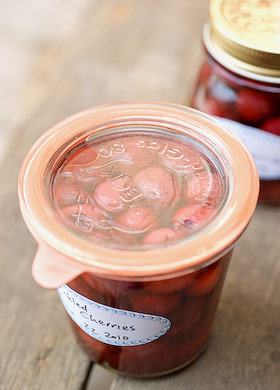
Then fellow CanJammer Leena posted her Chinese Five Spice Pickled Cherries for the June Tigress’ Can Jam, and the recipe is so simple I decided I’d give it a go instead. As is often the way with preserving, preparing the fruit can be the most time consuming part of the procedure; sorting the perfect fruit from the blemished, removing stalks and stones, topping and tailing. Readying my cherries was no exception. Years ago I’d bought my Dad a cherry pitter when he mentioned to me he was having trouble finding one and I’d bought another one for myself at the same time. I knew one day it would come in handy and twenty years later it at last had it’s first outing. You can dispense with pitting them altogether if you prefer.
So I pickled my cherries and canned them as well (just because I’m into canning), though the canning part may not be entirely necessary in this instance. You are supposed to leave the pickles to mature for at least a month but I opened a jar after only a week and they are heavenly. I’m now desperate to pickle more and stock the larder for when fresh cherries are just a vague memory of seasons past. I’m like a super sleuth on the trail for more cherries, sweet or sour. The CherryAid campaign is encouraging everyone to cook something during the British cherry season using British cherries, so do have a go at some pickled cherries. They aren’t too sweet or sour but just enough of both and even the syruppy juice is delicious drunk as a cordial. I can eat them straight from the jar but they do make a perfect pairing with goats cheese. If you have sour cherries they will have a bit more bite to work alongside stronger flavours.

I’m planning to plant at least one cherry tree this coming winter, now that this fruit has become my new best friend and I need my own supply.
CherryAid is holding a cherry themed FoodLovers Market in Soho, central London on Saturday 17th July (National Cherry Day).
CUCURBITS… I BEG YOUR PARDON?… CUCURBITS
Thursday July 01st 2010, 11:03 pm
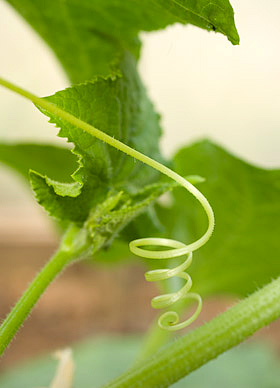
Each month when the Tigress’s can jam canning challenge ingredient has been announced, I’ve been relieved that it wasn’t up to me to choose. Being the only Brit taking part, it seemed such a massive responsibility to come up with a seasonal ingredient that would somehow accommodate all canjammers, travel half way around the world and fit into everyones canning calendar. Then the other day Tigress emailed me to say it was my shot and for a moment I was filled with dread. I say a moment, and it really was just a moment, as if by divine suggestion, the word ‘cucurbits’ fell from the sky and landed right on my head. The Tigress’ Can Jam ingredient for July is cucurbits, but it’s cucurbits with a proviso (see below).
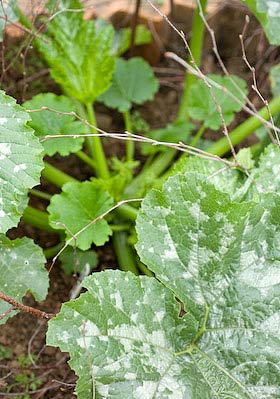
In case you aren’t familiar with the term cucurbits, it refers to Cucurbitaceae, a plant family commonly known as melons and gourds, including crops like cucumbers, squashes (including pumpkins), loofahs, melons and watermelons…. So what’s the proviso? First let’s dispense with the loofahs! (too chewy), secondly, pumpkins and winter squashes, they’re out. It is most likely too early for them anyways but also they are troublesome ingredients to deal with for hot water processing and I aint taking responsibility for that.
So that leaves cucumbers, a traditional pickling favourite and one I want to learn lots about from you experts over in the US. (By the way, as far as I’m concerned, bread and butter pickle should actually contain what it says on the jar. Likewise ‘coffee cake’ Anyhow, I digress…) Summer squashes such as courgettes and marrows… ha… gotcha! Of course this is yet another strange difference in the language we share. To all you canjammers in the US, small zucchini and zucchini. I have Sarah at Toronto Tasting Notes to thank for help translating here. And finally, to bring a luscious sweetness to the proceedings, melons of all types.
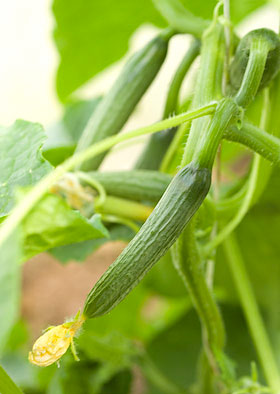
I’m hoping this group of ingredients is specific enough to make sense as well as being wide enough to cater for everyone. I am finding that Tigress’ Can Jam is giving me the opportunity to try new ingredients I’ve never worked with before, as well as making me approach familiar ingredients in new ways or ways I hadn’t got round to trying. I think these cucurbits offer scope for all manner of pickles, chutneys, relishes and jams and I can’t wait to see what everyone comes up with, as six months in, the canning done so far has been a total revelation. As previously mentioned, I want to learn how to can my cucumbers like I’m in that Little House on the Praire. Marrows, zucchini to most of you, I’ve always considered a waste of everybodies time, but I’m now ready to reconsider. There are endless recipes for marrow chutneys and jams and as this vegetable is effortless to grow, I really think it is time to learn to love this clod-hopping monster of a gourd.
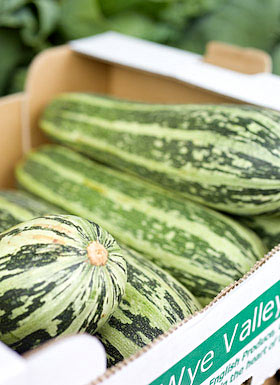
Courgettes, or small zucchini, are one of those glut kitchen ingredients that there are never enough uses for to reduce the surplus mountain, so it will be fabulous if some of you could come up with some essential recipes that the rest of us can’t live without.
And then there are the melons…. they fill me with such romantic notions; from the pickled watermelon rinds I’ve read of and dreamed about tasting, the spicy syruppy concoctions that might be sweet and sour at the same time, and finally, French inspired preserves, combining melon with lemon, or ginger, or raspberries, or peaches, that transport you to a village in Provence. Are you getting the gist?
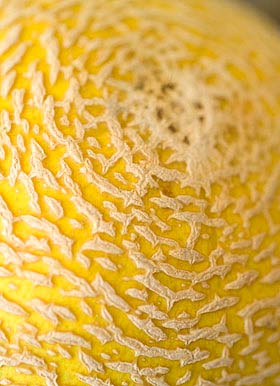
I hope you feel inspired to go off and make cucurbits your own. I can’t wait to see what you come up with. If you need to refer to Tigress’ canning guide you will find it here. All recipes must be posted between friday july 16 and friday july 23rd, with friday july 23rd at midnight being the cut off point. Tigress has allowed two extra days at the beginning this month so if you are so inclined and you can get your post up on the earlier days, please do! as it will help her to get a head start on the round-up. (Bravo Tigress for all your work).
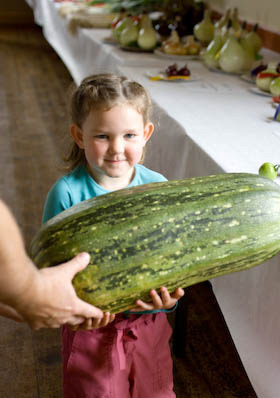
THE START OF A BERRY ENGLISH SUMMER
Sunday June 20th 2010, 12:02 am
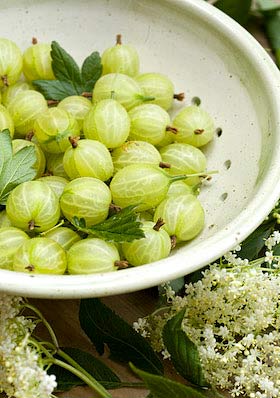
Month six Tigress’s can jam canning challenge and for June the choice of ingredients is positively bountiful with anything ending in ‘..erries’. As if that wasn’t enough, after other can jammers queried what that meant, the category was widened even further to include anything ending in ‘..urrants’ as well. I am just hoping that we haven’t covered the whole soft fruit spectrum in one fell swoop. With summer officially about to begin, at last the preserving year is shifting up a gear and a dearth is just starting to resemble a glut. After last months project, my rhubarb ketchup, that was a success but in a brown kind of way, I’ve been yearning for something colourful and British, something that sings a song of summer, con brio, whilst at the same time celebrating the beginning of the soft fruit season. So gooseberries it is.
I have cooked with gooseberries before but not to any great extent. Gooseberries are another fruit that seem to grow easily and yet are underused and under appreciated, an old fashioned country berry with an unfashionable reputation. This is another one of those puzzling fruits that is everywhere but at the same time hard to find. You either have to grow your own or know someone else who does. I’ve recently planted a few bushes on my newly acquired allotment, and though there wont be any crops to harvest this year, hopefully they will bear fruit-a-plenty in the years ahead. Varieties come with down to earth names, like Leveller, Invicta and Pax, very much old-school allotment sounding. More recently food writers have started to feature gooseberries, so perhaps they are on the cusp of a renaissance.
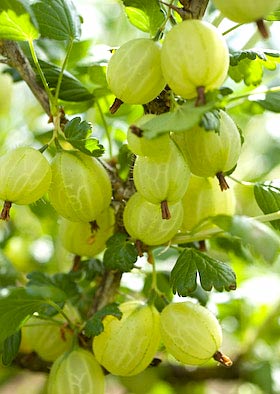
For the canjam I have chosen to make a gooseberry and elderflower jelly. There is something so pure and delicious looking about jellies and in this instance the end colour, though a glorious pinkish amber is nothing like the fresh green that the fruit starts out as. I have read that if you cook gooseberries in a copper pan they retain their green colour, but as I have no direct experience of this, I am loath to pass on the information parrot fashion. In my stainless steel jam pan, green gooseberries tend to turn an unappealing khaki colour as they cook but once the extracted juice and sugar begin to work together, an altogether more magical hue develops. Elderflowers make a classic partnership with gooseberries and should be ready for picking at the same time, though the flowers are much more fleeting. Here, in the Forest of Dean, the flowers have been in bloom for about two weeks but the berries are only just starting to ripen. I’ve used fresh elderflowers but you could use elderflower cordial instead if the only flowers to hand are past their best.
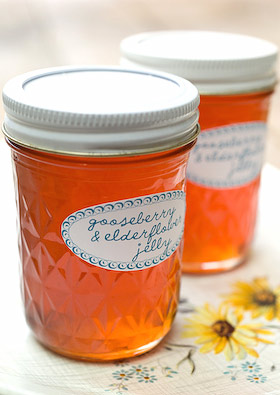
GOOSEBERRY AND ELDERFLOWER JELLY
Makes approx 1.3kg (3lbs)
2Kg (4lbs 8oz) gooseberries, rinsed and drained
approx 20 freshly picked elderflower heads
1 lemon
sugar
There’s no need to top and tail the fruit. Place fruit in a pan with 1 litre (1 3/4 pints) of water. Add the elderflowers and heat the pan, bringing to a simmer, then cook gently until the berries are soft and start to burst. Pour into a jelly bag (that has been sterilised by boiling for 5 minutes beforehand) suspended over a bowl, add the juice of the lemon and leave to drip overnight to collect all the juice. Discard the pulp remaining in the bag and measure the juice. Pour into a preserving pan and add 450g (1lb) of sugar to every 600ml (1 pint) of juice.
Prepare the water bath, jars and seals ready for canning. For more info about how to hot water process, refer to the guide here. Stir the syrup over a low heat until the sugar is completely dissolved then turn up the heat and boil rapidly to reach setting point. To test for a set, drip some syrup onto a cold plate and see if it quickly forms a skin that will wrinkle when you push your finger across the surface. Alternatively, use a jam thermometer and when it shows 105C (220F) you know setting point has been reached. (I usually employ both methods at the same time to be on the safe side!) Pour into the jars leaving required headroom for your type of jars, seal and hot water process for 10 minutes. Remove the jars from the water bath and leave them till completely cold before testing the seals are vacuum fixed. Label and store.
You can omit hot water processing if you wish as a jelly of this type should store well without, but processing makes it extra safe and will mean the jelly should keep for a year or longer.








